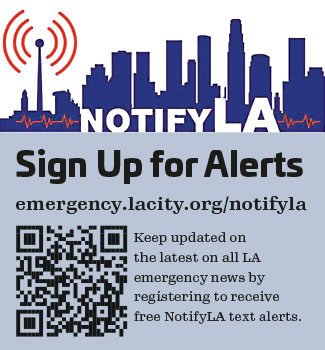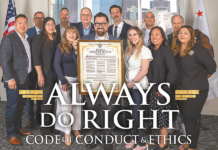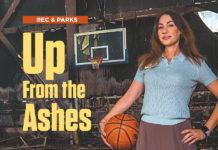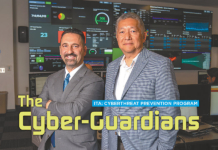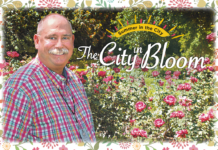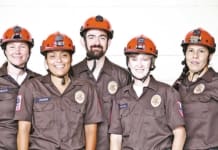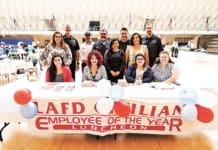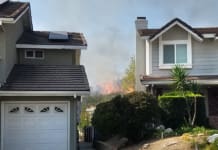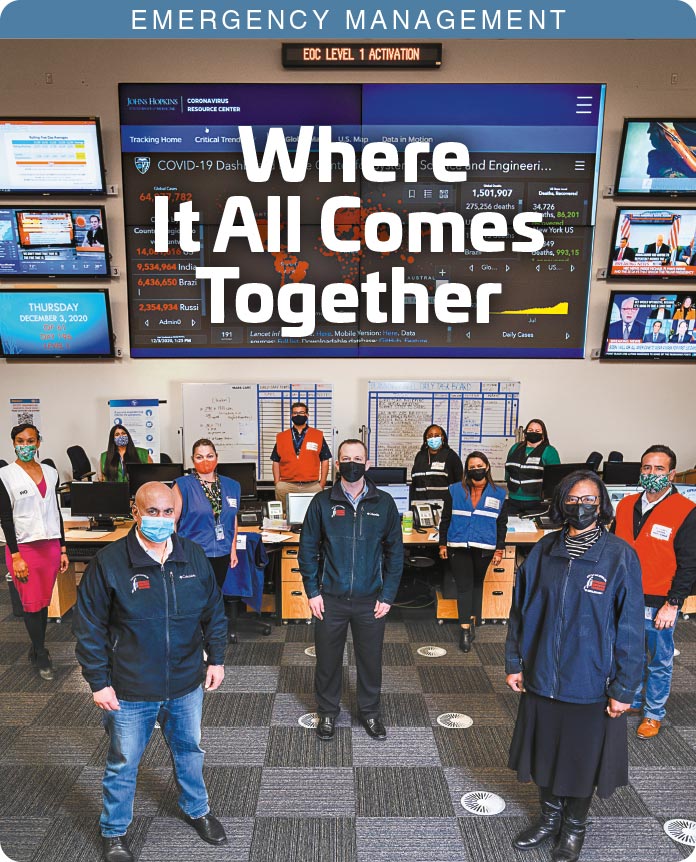 In the Emergency Operations Center are (from left): Front row: Aram Sahakian, General Manager, 31 years of City service; Gary Singer, Emergency Management Coordinator II, 5 years; and Carol Parks, Assistant General Manager, 22 years. Second row: Jessica Kellogg, Public Information Officer, 17 years; Crisanta Gonzalez, Emergency Management Coordinator I, 4 years; Jillian De Vela, Emergency Management Coordinator I, 3 years; and Anthony Aguinaga, Emergency Management Coordinator I, 20 years. Back row: Carmina De Santiago, Public Health Liaison, 2 years; Jon Brown, Emergency Management Coordinator I, 5 years; Veronica Hendricks, Emergency Management Coordinator I, 27 years; and Jaqueline Koci Tamayo, Emergency Management Coordinator I, 20 years.
In the Emergency Operations Center are (from left): Front row: Aram Sahakian, General Manager, 31 years of City service; Gary Singer, Emergency Management Coordinator II, 5 years; and Carol Parks, Assistant General Manager, 22 years. Second row: Jessica Kellogg, Public Information Officer, 17 years; Crisanta Gonzalez, Emergency Management Coordinator I, 4 years; Jillian De Vela, Emergency Management Coordinator I, 3 years; and Anthony Aguinaga, Emergency Management Coordinator I, 20 years. Back row: Carmina De Santiago, Public Health Liaison, 2 years; Jon Brown, Emergency Management Coordinator I, 5 years; Veronica Hendricks, Emergency Management Coordinator I, 27 years; and Jaqueline Koci Tamayo, Emergency Management Coordinator I, 20 years.
The Emergency Operations Center is the HQ for battling the City’s critical emergencies like COVID.
Photos by Summy Lam, Club Director of Marketing
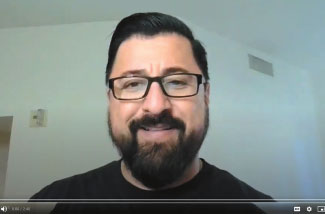
Beginning with a bond issue in 2002, the City changed the way it manages its emergencies. And 19 years later, that strategic move is paying dividends.
Voters passed Proposition Q that year, a $600 million Citywide public safety bond issue to improve, renovate, expand and construct public safety facilities. Approximately $107 million of that bond measure was earmarked for the site/land acquisition, design and construction of the new Emergency Operations Center.
The center brings many critical functions into one modern facility to manage major emergencies like fires, earthquakes, chemical and gas leaks, road collapses, acts of terrorism, episodes of civil unrest, and many other situations.
This, obviously, is the first major pandemic the Emergency Management Dept. has faced, and the critical thinking that led to the building of the EOC is paying dividends.
Read the Alive! interview (below) for more information about how the City is managing this crisis.
About the EOC (Emergency Operations Center)
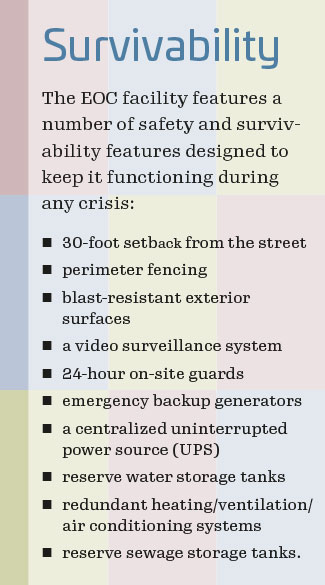 The EOC is the focal point for coordination of the City’s emergency planning, training, response and recovery efforts. The EOC processes follow the National All-Hazards approach to major disasters such as fires, floods, earthquakes, acts of terrorism and large-scale events in the City that require involvement by multiple City departments. Also co-located in this state-of-the-art, 84,000 square feet, two-story, seismically-base-isolated facility are a new Fire Dispatch Center, the Fire Dept. Operations Center and the LAPD’s Dept. Operations Center.
The EOC is the focal point for coordination of the City’s emergency planning, training, response and recovery efforts. The EOC processes follow the National All-Hazards approach to major disasters such as fires, floods, earthquakes, acts of terrorism and large-scale events in the City that require involvement by multiple City departments. Also co-located in this state-of-the-art, 84,000 square feet, two-story, seismically-base-isolated facility are a new Fire Dispatch Center, the Fire Dept. Operations Center and the LAPD’s Dept. Operations Center.
EOC features include a main coordination room (MCR), a media center, a training room, a management section room, a public information officer room, an executive conference room, six flexible-use breakout rooms (including a business operations center), an amateur radio operations room and two storage rooms.
Departments represented in the EOC include the LAPD and the LAFD (including mobile and airborne hookups), Transportation, the DWP, Public Works, Rec and Parks, Emergency Management, Harbor and Airports. The EOC also contains state-of-the-art audio and video communications capabilities and weather and seismic monitoring.

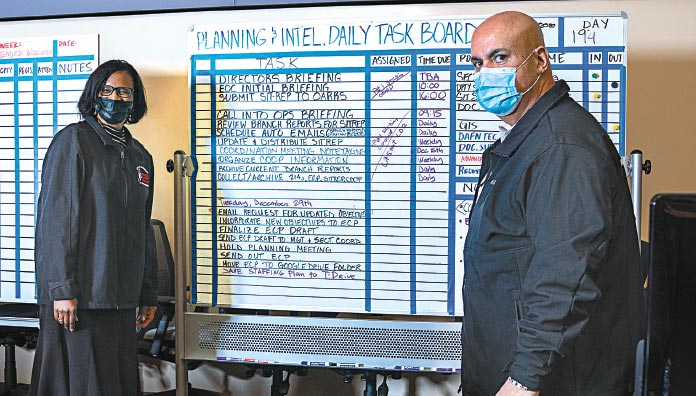
‘We Are Key’
On Dec. 3, Club COO Robert Larios and Alive! editor John Burnes interviewed three from the Emergency Management Dept.: Aram Sahakian, General Manager, 31 years of City service; Gary Singer, Emergency Management Coordinator II, 5 years; and Carol Parks, Assistant General Manager, 22 years. The interview was performed via Zoom due to the Citywide lockdown; the Alive! cover photo shoot was performed with social distancing.
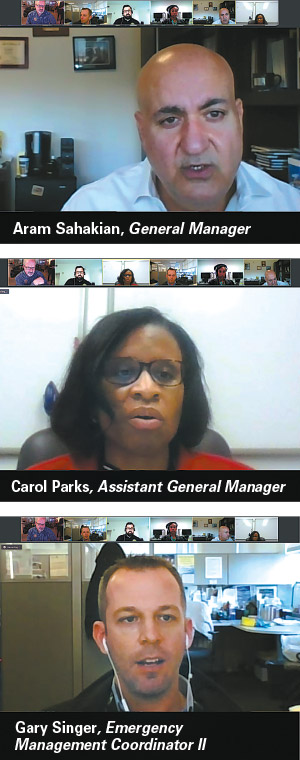 Alive!: Thank you Aram, Carol and Gary, for taking the time to speak to us. We know your time is precious as you pass your 200th consecutive day of COVID management. Aram, give us a brief view of your career trajectory and how you got to where you are right now.
Alive!: Thank you Aram, Carol and Gary, for taking the time to speak to us. We know your time is precious as you pass your 200th consecutive day of COVID management. Aram, give us a brief view of your career trajectory and how you got to where you are right now.
Aram: I’m an electrical engineer. I started working at DOT in District Operations. I was there from 1989 to 2016. District Operations does a lot of traffic signal and stop sign studies. From there, they promoted me to the ATSAC Center, the Automated Traffic Surveillance and Control Center. You guys have covered that.
Right.
Aram: Four million-plus traffic signals in the City. They are all connected via fiber optic to the ATSAC hub in Downtown LA. From there, I went to Metro LA Construction. I was a Project Manager on a couple of the subway stations, the Blue Line at the time. I saw that they had a special Traffic Operations Division, which managed more than 4,000 events annually, about 300 major events such as the Academy Awards, the Grammys, marathons.
We covered that division, too.
Aram: Yes. So I was the incident commander from DOT on those events, and then when I saw that we really needed to start getting involved in Emergency Response, and when I showed the value of what DOT could do for Police and Fire, their immediate reaction was, “We have a resource here we haven’t been using. We need to start working with DOT.” My approach was, “Not only DOT, but the Bureau of Street Services in Public Works. You have enough incidents to justify the creation of a civilian agency.” They all agreed. It goes back to my working with the LAPD closely for the 2000 DNC convention. We managed all the demonstrations – planned and unplanned. My last two projects at DOT before I was asked to head the Emergency Management Dept. were Carmageddon and the Space Shuttle move from LAX to the California Science Center museum in Downtown LA. That elevated me to a higher level. At that point in 2016 the mayor appointed me as GM of EMD, and here I am.
Thank you. Carol, how about you?
Carol Parks: And just as an interesting aside to what Aram just said, he and I worked together on several events prior to him becoming General Manager. He was key to the Emergency Management Organization as the DOT Representative because like he said, DOT was an important component in the City’s emergency operations organization. He would get the late night calls from Police and Fire from our Department to help when emergencies occurred. Little did I know he would be my boss one day. So it’s a real small world.
Aram: That’s right!
Carol: I’m originally from Atlanta. I began my Emergency Management career at Atlanta-Fulton County Emergency Management Agency and then transferred to Georgia Emergency Management Agency. It was an exciting time in my career because of the upcoming 1996 Summer Olympic Games in Atlanta and I had a major role with hazmat planning. In 1995 marriage brought me to LA and after being here for awhile, I joined the City in 1998 as an Emergency Preparedness Coordinator I. I stayed in that capacity until about 2000 when I became an Emergency Preparedness Coordinator II overseeing community preparedness activities. And then this year in April I was promoted to Assistant General Manager.
The Emergency Management profession has changed tremendously over the last 10 or 20 years. It has proven to be quite valuable. I have enjoyed working with several General Managers both on the East Coast and on the West Coast. Emergency management is a lot different depending on the size of the city, so our role is a very important one because we serve four million people.
Great. Gary, same question.
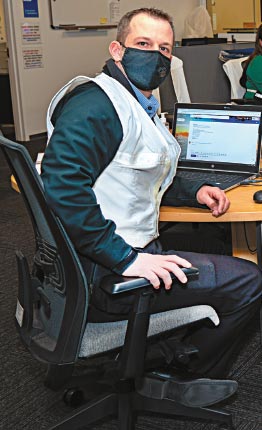
Gary Singer: I started in Emergency Management in 2002 where I was on a volunteer search and rescue team for the City of Commerce. I worked in that capacity for a little while before joining the City Emergency Preparedness Officer for the City of Commerce. I did that until 2010, when I took a job at Cal State Dominguez Hills as their Emergency Preparedness Coordinator. I was there until 2015 where I took a job here in the City of LA as an Emergency Management Coordinator. I’ve been here from 2015 until now.
You come from a Fire background?
Gary: Yes. It was a volunteer urban search and rescue team for the City of Commerce. They didn’t have their own fire department. They contracted with the County and they were told that during a major earthquake, resources would be spread thin so there was a chance that they might not have all of the resources they needed. So they trained and staffed a volunteer search and rescue team so if there was an earthquake, the city would have a dedicated resource to help its residents.

 History and Size
History and Size
Let’s talk briefly about the history of the Emergency Management Dept. How long has it been in operation?
Carol: Our Department started out as a division within the CAO’s Office and in 2000 we became our own department. Our first department name was Emergency Preparedness Dept. We’re actually celebrating our 20-year anniversary and voila, look how we’re celebrating it!
In covering a lot of the City’s COVID emergency stories over the last eight or nine months, it seems like the City is really ramping up its emergency response. Rec and Parks built their own Department Operations Center; Sanitation created the CARES team. And other departments stepped up, too. It seems it was really good timing for the City to ramp up its emergency operations in a lot of different departments before the pandemic hit, and of course yours especially. Is that accurate?
Aram: It is, but unfortunately, our Department’s getting smaller. We lost five employees to the separation incentive program. We’re a small department, keep that in mind. We’re fewer than 22 people for a population of four million. The rule of thumb is 40,000 per emergency management coordinator. Our numbers should be about 60 to 70, but we are already extremely lean. As much as I would like to say that we’re growing based on emergencies and responses, the Department is getting smaller as far as personnel resources.
We’re trying to become more efficient. We’re reaching out to sister agencies to see how they can fill the gap. Unfortunately, some of them also have their own gaps that they need to fill. They lost a lot of people also. So the fiscal situation is uncertain. It’s taxing. We don’t know what’s on the horizon, if there are any furloughs. We are listening to the mayor and the CAO. These are unprecedented times and we are part of history, make no mistake about it. This is a 100-year pandemic. We haven’t seen it in our lifetime and we hope we won’t see another one. We were dealing with sinkholes and fires and earthquakes. The largest one we witnessed was the Northridge earthquake. I was at the DOT at the time. And honestly, I think it was that earthquake that triggered separating EMD from CAO’s office, bringing it from a division to a full department.
We have several emergencies on a monthly basis. It seems like the severity and the frequency of these emergencies keep going up. Seventeen of the largest 24 fires in California history were in the last 24 to 28 months. I don’t care what you call it, climate change or whatever, the frequency and severity are increasing. And now we’re hit with a pandemic, which is an unknown. It’s outside of the comfort zone. With all the preparations we’ve been doing – preparing our constituency, preparing the departments, looking at our annexes – the timing to invest into the Emergency Management Dept. of the City is now more than ever.

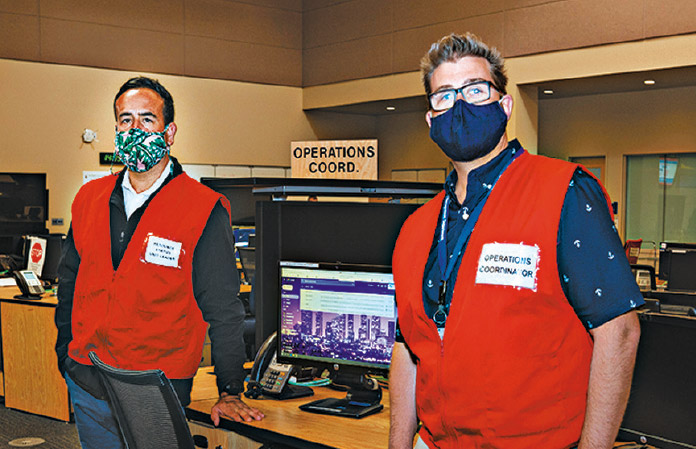
The City’s Coordinator
Is the Emergency Management Dept., for lack of a better term, the quarterback of this emergency response, the coordinator of the City’s outreach? How would you describe your place in the City’s response to COVID?
Aram: I wouldn’t say we’re the only quarterback because there are many missions out there that are addressing COVID-19. I’ll give you an example, the LAUSD [Los Angeles Unified School District]. They are feeding hundreds of thousands of students. They’re the quarterback for that mission. Now if they come to us and ask us for support from the EOC as far as logistics, obviously we will go ahead and support that. But they’re the quarterback; they’re running the show. Now having said that, there are numerous other events that yes, the EOC has been spearheading, assisting and supporting all these missions. It could be testing sites. It could be shelters. It could be quarantining. We’re basically sitting and playing chess and ensuring that the soldiers are moved in the right squares assisting all the missions out in the field.
‘We connect all the City departments that are leading the response [to the pandemic].’
— Aram Sahakian, General Manager, Emergency Management Dept.
Carol: We are the City’s coordinator for the overall response; the Emergency Operations Center is the glue. We connect all of the City departments that are leading the response. We have been activated since day one to look at this issue, and not only are we working with the City departments but also outside agencies at the City, County and State level. We are looking at not only what’s happening at the City but Aram is a part of an even bigger network where he communicates with the big cities and gets lessons learned and best practices, and we use that information to inform a lot of the decision making that’s happening here. We are key. Daily we answer the phone and put out reports, and we are there as a resource. Many of the City departments are telecommuting, but we are what could be considered “second responders” who have been reporting every day to the Emergency Operations Center monitoring the situation as it continues to go up and down and change. When the numbers [of those infected] were going down, we were there, and now that the numbers are increasing, we’re still here playing the same role and sharing information. We collaborate and assist the mayor and the other elected officials in their efforts and provide them information. We are the key coordinators of this response.
Aram: That’s right, the key coordinator. I can give you an example. Some of these projects are complicated. For example, setting up a hospital at the Convention Center. Truly, there’s no one quarterback. There are several agencies that were extremely important to the process. You have a medical team that basically designs and puts the business plan together. From there you have logistics teams that look at it and decide what personnel resources and what infrastructure are needed. Then all that is communicated to the key agencies, then it comes to the EOC. The EOC looks at it and says, “Fine. We need to sign a contract for nurses.” There are not enough in the county, so we go to an RN registry. “We need to contract for laundry. We need to contract to set up cots and put in dividers.” It has many elements. At some of these meetings you could have up to 25 or 30 agencies at the table. There is no one person throwing the ball. We are all working together. The ultimate decision maker is the mayor on top, but he has confidence in us and he has tasked us with the mission of realizing these important projects.
Gary: There’s an important distinction between EMD, the Emergency Management Dept., and the EOC, the Emergency Operations Center. Running the Emergency Operations Center is one of the one or two most important things that this Department does, and it would be fair to say that we are kind of the quarterback of the EOC. We have a good idea of how a good EOC is supposed to run, and it’s our job to be the quarterback in there and to make sure that everything is running smoothly.
Aram: That’s very true. We are the quarterbacks of the actual Center. We make sure that all the departments and divisions that are needed are at the table coordinating. It’s seamless coordination and documentation. But when it goes to the mission outside the Center, we are only a component of it that supports those missions.

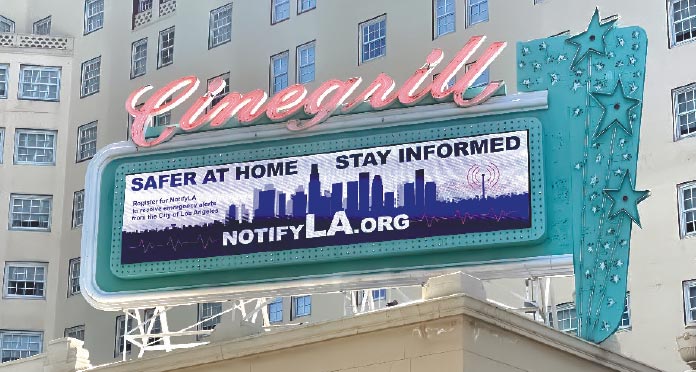
The Role of the EOC
So that leads into describing the EOC, then. Tell us what the EOC does.
Gary: I’ll give you the Cliffs Notes because there are a number of different things. Number one, the EOC is the brain of the City’s response to any emergency. When you have a big emergency, let’s say an earthquake or a fire because those are the easiest to conceptualize, you have lots of things going on throughout the City, and every one of them is a 10 on a scale of 1 to 10 in terms of importance for the people on the scene. If we’re talking about an earthquake, you’re looking at a fire, you’re a fire chief and you think that that’s the most important thing in the City. But the EOC takes all of the information from throughout the City and it’s able to prioritize what’s the most important. You get a big picture view of everything that’s going on in the City and not a compartmentalized view. Number two, it brings the different departments together into one, under one roof. You’re able to share and communicate information so you’re not working in a silo. Having a center where each of the departments involved in a response can go is critically important. A third thing we do is collect, acquire and allocate resources. The City is very resource rich. We have a lot of things at our disposal. But those things that we don’t have at our disposal we’re able to get. If we don’t have it, we can rent it, buy it from the private sector or ask for it from the County of Los Angeles. The County, if it doesn’t have it, could ask for it from the State and so forth and so on. A fourth thing that we do is because we’re the brain, we’re able to disseminate information. We have all the information and we’re able to send it out, both internally to the City family and externally to the public. We also are able to send out public notifications via Emergency Mass Notification Systems. So there is a number of different things that the EOC does.
Aram: You guys should have received one last night, right, the order?
Gary: If they registered for Notify LA, you would have got it.
I am registered, and I did get one, yes. The stay-at-home order.
Aram: Registration is easy. Make sure you sign up so you get all our emergency notifications.
Carol: To add to what Gary was saying, the Emergency Operations Center is activated at three levels with Level 1 being the highest. Prior to this pandemic event, most of our activations were at our lowest level, Level 3. This EOC activation is the first time that the EOC has been activated at Level 1 since we’ve been in this building. Our highest level.
 Preparing for a Pandemic
Preparing for a Pandemic
How do you prepare for a pandemic?
Aram: That’s our Planning Division. We have a whole division dedicated to ensure that our City agencies and Departments including the Council Offices, operate according to a continuity of operations and a continuity of government plan. So we play the what-if scenarios based on the incident. Obviously, this was something new. It was more challenging than some of the other incidents that we’ve been dealing with over the years.
Each incident has an annex. This one has a pandemic annex. We always had a pandemics annex, but it did not include a COVID-19 incident. It included some other infectious diseases but not a COVID-19, which is more challenging. Six or seven months into it, we have more data now – the social distancing, the use of PPEs and what have you. We should mention that County Health is the lead on any health-related emergency. We coordinate with them.
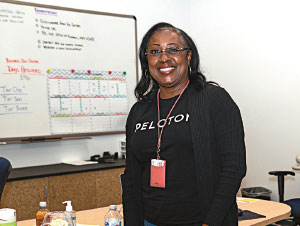
In January, we began looking at the pandemic annex. We consulted with health professionals and included the new elements needed to address a COVID-19 pandemic-type of a scenario. This will not be the final form of this specific annex. I’m sure that in the future it will evolve and again, I’m knocking on wood – hopefully we don’t have more pandemics. But pandemics are a different animal. It’s unlike a fire. It’s unlike a sinkhole. It’s unlike a mudslide. It has way too many parameters that are unknown, and they evolve. That’s why it’s a dynamic plan.
In a nutshell, each incident has an annex. It’s in the emergency plan and we have a response to it and we keep reviewing those plans on a biannual basis. The departments submit them. We communicate with them, and we submit them all the way up to the Federal level. It’s a Federal requirement. There is a very clear incident command system that we need to follow, and that comes down from FEMA. If you need reimbursement to respond to any incident, you need to follow that process.
Carol: In this profession we have to prepare for all hazards – natural, manmade, technological. If there were any level of preparedness for this pandemic it would be attributed to the planning that we do on an ongoing basis. All of our planning documents – and we have more than 40 of them – are living documents, meaning that once they are written they have to be revised. We have to train to them and then exercise them with all of the key players. Within City government, emergency planning is something that we did to prepare. No one on the globe was totally prepared for this pandemic. But the little level of preparedness that we had would be attributed to our ongoing planning, training and exercise program. As far as preparing the community, that gets into our Ready LA Neighborhood Initiative. We’ve done a lot of work in trying to prepare the public for disaster. We didn’t necessarily promote or plan for a pandemic with them. It’s mostly been for catastrophic earthquakes. But in all of our preparation and all of our messaging we encourage them to think about how they could develop their own personal preparedness plan for any eventuality that could occur. But as Aram mentioned, this is a novel event with so many different twists and turns that it’s just been a surprise element for all of us.
Aram: And honestly, the real emergency is not being prepared. That is the true real emergency.
Carol: Yes.
Gary: We’re doing a good job of piggybacking off of each other. In the EOC we’re concerned generally about how well and how smooth that facility runs. It doesn’t matter what’s going on outside of the walls, whether it’s an earthquake or a fire or, you know, a planned event like the LA Marathon – as long as the facility is running right and all of the processes and procedures are on point and the staff is trained, it doesn’t matter what’s going on outside as long as what’s going on inside is running efficiently and smoothly. Having trained staff and trained responders show up and know each other and know how to acquire and allocate resources or gain situational awareness, as long as that’s done right it helps any hazard that we may run into.
Is it safe to say that the experience and planning gained from this will help the next generation if there’s another pandemic?
Gary: Yes. Yes.
Carol: Most definitely.
Gary: I think there’s a lot of lessons learned and we’re still getting those right now. But pandemics are kind of unique. Sometimes you don’t know how they’re going to affect, and to what extent, the population. But there are definitely elements in this pandemic that we can capture and use for the future in our plans and annexes.
Aram: It’s really important to learn from mistakes. We’re human. We all make mistakes. There’s always room for improvement. We do after-action reports for each incident. For this COVID-19 incident we hired a private contractor because it’s beyond our scope. It’s a huge undertaking and we don’t have the resources to do it internally. Besides, an outside agency will give you more of an unbiased after-action report so we’re not patting ourselves on the back. We’re improving constantly but with the pandemic especially, there are a lot of lessons learned, especially when it comes to coordinating and communicating with sister agencies and honestly, navigating the political arena.
 Difficult Days, Success Stories
Difficult Days, Success Stories
You all seem pretty well adjusted and getting your sleep finally, but there must have been some really rough days, and maybe there are some more to come.
Aram: I’m not sure we’re relaxed and resting! Because I can tell you I’m not. These two guys call me at all times of the day.
Carol: I was the Duty Officer when Aram called – it was on a weekend, when time things were just starting to unfold. The Mayor’s Office had Aram on speed dial, asking him how we were going to deal with this pandemic and how we could find out what’s going on all over the world. I immediately called the Planning Division Chief. His whole team was working. We looked at what was happening with COVID all over the world. And we had to do it in about an hour or two, to come up with this comprehensive report and then figure out the impact on Los Angeles, and how to get the word out using all forms of technology.
Wow.
Carol: That was my big moment with COVID. The next big moment was dealing with the Marathon, and I was the Duty Officer again for that. The organizers decided to go ahead and do the race but thank God that was a pretty well-run event this year. And last of all, I’ll say this and I’ll be quiet, the other time I was the Duty Officer we had the major protests for racial justice along with COVID. So I was dealing with emergency after emergency and just trying to keep the staff here calm. They were working really long hours at that time. Part of my job was giving them the confidence that we can get through this. The most challenging thing with this whole COVID situation is we don’t know when it’s going to end. Normally in all my years of being an emergency manager it follows that the emergency happens, the emergency concludes and then you get into recovery. We’re still in response. Recovery hasn’t started yet.
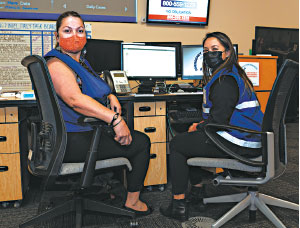
Aram: It’s relentless. It’s one event after the other. Honestly, at least since I moved to EMD, it seems like the numbers have skyrocketed.
I can tell you that when knowing that Carol is the Duty Officer, I am in a comfort zone because I know that everything’s going to be addressed with flying colors. It’s a stressful job. It’s a 24/7 job. I carry my phone in my bed because I’m nervous that I’m going to miss a message. I’ve had several incidents where my waking up at 4 a.m. and reading an email saved the day. That ping, is in my ear the whole time. The same goes with all our staff. They’re dedicated. There is such a thing as exhaustion, but we try to keep morale high. We try to accommodate staff and create a very healthy work environment by giving them the tools we need. And thank God that the light at the end of the tunnel for this event is the vaccine, and right now we’re working on the vaccine plan. It’s an extremely complicated plan. I had hair when I came to EMD, by the way, a full head of hair!
Gary: Actually I was not in the EOC at the very beginning of the pandemic. I had my first child right in the middle of the first week of community spread.
Congratulations!
Gary: Thanks. But just a week or two after that I was on the phone with the EOC getting back to work through telecommuting. You could hear it in the voice of the people there that it was hectic and it was stressful; there was a lot to be done and not a lot of time to do it.
Just looking at the national news coverage, LA and LA County were leading the efforts of getting testing out there, and it was good to see that. I was proud to see that the EOC was running smoothly. Even though I wanted to be there, I could say that they were handling it well.
Talk about some success stories that through all of this you can be proud of.
Aram: There are several. Number one, we’ve been activated for 200-plus days. We have a very high level of activation, and have more than 50 to 60 percent of the responders work virtually and are able to run the Emergency Operations Center. We had to bring in new technology to do that. For example, we brought in VEOCI, our new record keeping request form technology, during the pandemic. Secondly, we signed a contract with Honeywell for N95 masks; they are giving us 1.2 million a month, of which we keep 120,000 based on our burn rate. We give the rest to the private sector because they were running short. So that’s another success story. The RYLAN [Ready Your LA Neighborhood] planning program, which we instituted before the pandemic, had families coming and telling us, “Your RYLAN planning saved lives in our complex because as a community we were together and we knew what to do.”
Aram: Yes.
Carol: Especially considering that, when we first started back in March, we had five more staff than we do now. That takes a lot of mental stability. We call this a sustained operation. We’re not doing just one thing. We’re not just here training, for example, but we are contributing to whatever Police is doing, what Fire is doing, the Mayor’s Office and all the City departments. Personnel is running the DSW [Disaster Service Worker] program, and we’re able to support all of these multifaceted functions that are going on to relate to the COVID response.
Aram: Ultimately, I have no doubt that the work we have been wdoing in the EOC since March has saved lives. It saved probably many lives, and that’s the biggest success story.

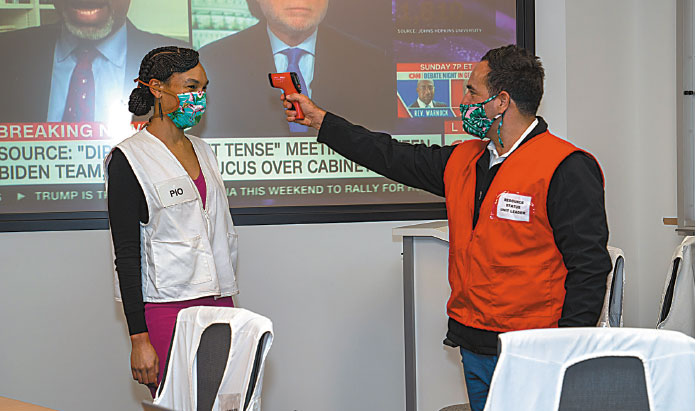
Steady Crew
Talk about your crew, the 22 people who work in the department.
Aram: Without them, there would not be an EMD. I tell my team, “I work for you. I want to make sure that you have the tools to do your job.” That’s the bottom line. And to create a work environment that ensures that they’re productive and thriving. They’re all dedicated. Several had concerns because they had elderly at home that they were taking care of. We’re not COVID-proof. We’ve had three COVID cases so far in the last several months I believe. We have very tight protocols of PPEs and social distancing.
Carol: Our emergency managers have put their personal lives aside and make coming to work a priority. Some of our employees telecommute and support us in their remote capacity, but those who have been coming into the office every day have really stepped up. Because of COVID, really we’ve had to bring all of our emergency managers from their usual job in the various assigned divisions to commit to working in the EOC, and they have taken off their day-to-day hat and put on their EOC hat and stepped up in a lot of different capacities.
Aram: It’s unlike any other job because it’s not just what you know – what training you have. It’s character. You really need to have the character to be an emergency responder because you need to go above and beyond the norm to do your job and to do it right. It takes that emotional EQ to get you to the next level. It’s not just your IQ.
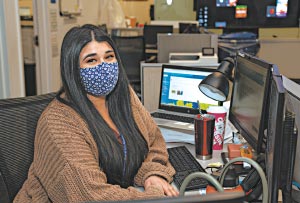
Why do you love what you do?
Aram: Because I feel that I was put on this planet to help people. That’s my true north. And that’s what I’ve been doing. Personal satisfaction. I love my City. I love Angelenos. And trust me, I would not be here if I didn’t love what I do. It’s the love of the job that keeps me here.
Carol: Just knowing that maybe something that I did helped to save a life or to make someone else’s day-to-day living more beneficial. Just knowing that I have helped inform some other employee or some other Angeleno about the importance of being prepared, that one day when they need it, when it’s a bad day in LA that they will remember something that I may have said or done, and it will save their lives or the lives of their family members.
Gary: How am I going to top all that? Come on!
I would echo what Aram and Carol both said. On top of that, this field is very unique. It’s a growing field. It’s a young field. When all three of us got into it, you couldn’t go to school to be an emergency manager, but now universities have degree programs where you could go to school and be an emergency manager. It’s a new enough of a career field to where you can shape it. You can be in at the ground floor where decisions are being made that are going to change the course of the profession moving forward. And working in a big city like the City of LA that is ground zero for a lot of emergencies and disasters, we have the experience that we can share with the entire country and entire world on how to respond effectively to emergencies. There are jurisdictions that don’t have the type of things that we have here and don’t have the experience that we have. So it’s unique being in this field, and it’s definitely unique being in this City.
Well, thank all of you for your time and your commitment and dedication to the City, especially during this health crisis.
Aram: Thank you for highlighting what we do. We are one small department, and sometimes we’re an afterthought, and what Alive! is doing will put us upfront. We really appreciate it.
You’re very welcome. That’s what we do.
Carol: Thank you.
Gary: Thanks, everybody. Take care. Be safe.


